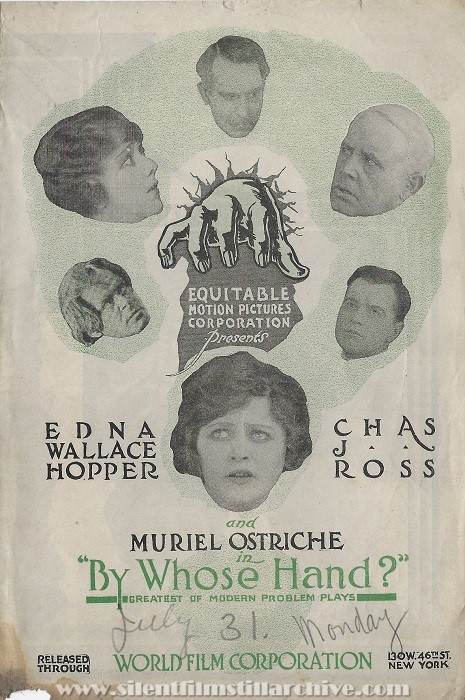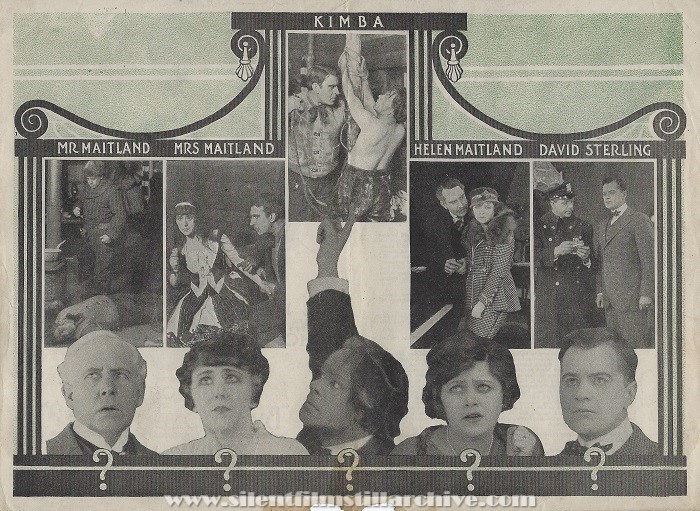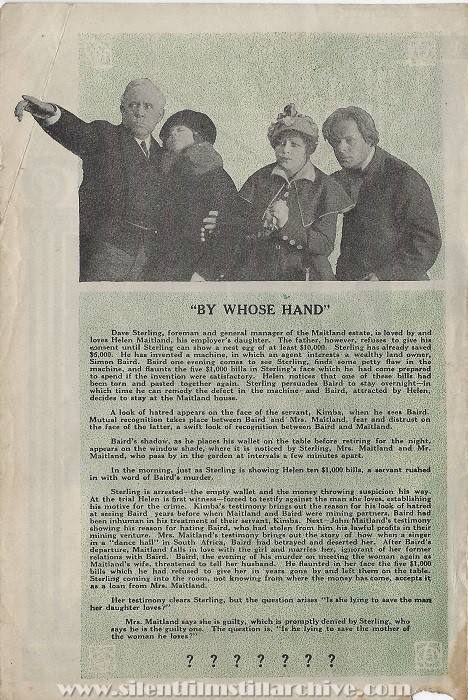![]()

By Whose Hand? (1916)

Equitable Motion Pictures Corporation
presents
EDNA WALLACE HOPPER
CHAS J. ROSS
and
MURIEL
OSTRICHE
in
"By Whose Hand?"
Greatest of
Modern Problem Plays
July 31, Monday (1916)
Released Through WORLD FILM CORPORATION
130 W. 46th
St. New York

Mr. Maitland Mrs. Maitland Kimba Helen Maitland David Sterling
? ? ? ? ?

"BY WHOSE HAND"
Dave Sterling, foremand and general manager of the Maitland estate, is loved by and loves Helen Maitland, his employer's daughter. The father, however, refuses to give his consent until Sterling can show a nest egg of at least $10,000. Sterling has already saved $5,000. He has invented a machine, in which an agent interests a wealthy land owner, Simon Baird. Baird one evening comes to see Sterling, finds some petty flaw in the machine, and flaunts the five $1000 bills in Sterling's face which he had come prepared to spend if the invention were satisfactory. Helen notices that one of those bills had been torn and pasted together again. Sterling persuades Baird to stay overnight -- in which time he can remedy the defect in the machine and Baird, attracted by Helen, decides to stay at the Maitland house.
A look of hatred appears on the face of the servant, Kimba, when he see Baird. Mutual recognition takes place between Baird and Mrs. Maitland, fear and distrust on the face of the latter, a swift look of recognition between Baird and Maitland.
Baird's shadow, as he places his wallet on the table before retiring for the night, appears on the window shade, where it is noticed by Sterling, Mrs. Maitland and Mr. Maitland, who pass by in the garden at intervals a few minutes apart.
In the morning, just as Sterling is showing Helen ten $1,000 bills, a servant rushed in with word of Baird's murder.
Sterling is arrested -- the empty wallet and the money throwing suspicion his way. At the trial Helen is first witness -- forced to testify against the man she loves, establishing his motive for the crime. Kimba's testimony brings out the reason for his look of hatred at seeing Baird. Years before when Maitland and Baird were mining partners, Baird had been inhuman in his treatment of their servant, Kimba. Next -- John Maitland's testimony showing his reason for hating Baird, who had stolen from him his lawful profits in their mining venture. Mrs. Maitland's testimony brings out the story of how when a singer in a "dance hall" in South Africa, Baird had betrayed and deserted her. After Baird's departure, Maitland falls in love with the girl and marries her, ignorant of her former relations with Baird. Baird, the evening of his murder on meeting the woman again as Maitland's wife, threated to tell her husband. He flaunted in her face the five $1,000 bills which he had refusted to giver her in years gone by and left them on the table., Sterling coming into the room, not knowing from where the money has come, accepts it as a loan from Mrs. Maitland.
Her testimony clears Sterling, but the questionarises "Is she lying to save the man her daughter loves?"
Mrs. Maitland says she is quilty, which is promptly denited by Sterling, who says he is the guilty one. The question is, "is he lying to save the mother of the woman he loves?"
? ? ? ? ? ? ?
"BY WHOSE HAND?"
(Equitable World -- Five Reels)
REVIEWED BY HARVEY F. THEW
THIS is an unusual story, with a mysterious ending, which leaves the audience to decide "who is guilty?" Moreover, it is excellently produced and acted by a capable company, which includes Edna Wallace Hopper, Muriel Ostriche and Charles J. Ross, whose names should hav a strong drawing power. Charming exterior scenes are supplemented by elaborate interior which establish a convincing atmosphere.
The dramatic unities appear to have een carefully weighed, and from an artistic standpoint the picture is a success. It should prove an equal success from the bos-office standpoint.
The story revolves around the Maitlands,a wealthy family of man, wife and young daughter, Helen. Helen is loved by Sterling, superintendent of the estate, but Maitland tells the young man he must show him $5,000 to prove he has "made good" before he can consent to the marriage.
Sterling is perfecting an envention; he show the machine to Simon Baird, a wealty land owner, who picks some minor flaw with it, and then flaunts $5,000 befoe Sterling's eyes, telling him he was ready to pay that much if the machine had been perfect. Baird is induced to stay the the home that night while alterations are being made. In the morning he is found murdered, and the $5,000 is in Sterling's possession.
At the trail a lot of past history of the Maitland family comes to light. Baird has been a partner of Maitland in a mining venture year before and had robbed him of his share. It also develops that Baird had known and wronged Mrs. Maitland when she was a singer. She confesses to the murder, saying that she had taken the money which Baird had denied her in other times when she was in dire need, and had loaned it to Sterling, whose suit for Helen's hand she favored. Sterling comes to the rescue and declares he murdered Baird himself. The audienc is left to decide whether Mrs. Maitland's confession was made merely to save Sterling, or whether he is a real murderer.
The story is the work of Channing Pollock and Rennold Wolf. It was staged by James Durkin. Others in the case are Nicholas Duneaw, John Dillon and James Ryley.
-- Motion Picture News, April 29, 1916, p. 2555
Two World Film Dramas
"By Whose Hand?" Leaves
Mystery Unsolved -- "The Social Highwayman," a Series of Sensational
Incidents.
Reviewed by Lynde Denig
"By Whose Hand?"
THE list of names introducing this Equitable drama is impressive in the extreme -- Channing Pollock and Rennold Wolf as co-authors of the story: Edna Wallace Hopper, Charles J. Ross and Muriel Ostriche as stars in the production made by James Durkin. Surely something out of the ordinary is to be expected from a combination such as this, and the result is not disappointing.
"By Whose Hand?" originally called "Who Killed Simon Baird?" ends with a question mark, suggestive of the termination of an episode ina serial rather than a complete five-part photoplay; but even if the mystery remains unsolved, an audience that has followed the evidence presented at a protracted trial is not left entirely in the dark. Probably there will be little difference of opinion about the identity of the murderer, and if there is a disagreement, so much the better. Unless a picture is interesting it does not excite talk.
Confirmed photoplay patrons may fear a tedious half-hour when they discover that the greater part of "By Whose Hand?" is a court room prodiction; but gradually they will find themselves becoming more and more concerned in the progress of the trial, advanced with exceptional skill to create suspense and a comprehension of the motives of the characters. We know what has happened; how Baird, while in the home of Maitland, was killed by a dagger thrust from behind a curtain, and how circumstantial evidence indicated Dave Sterling as the assassin, and we also know that Kimba, an Eskino in the employ of Maitland, cordially hated the murdered man.
During the trial, as first one, then another of the sitnesses appears on the stand, scenes dissolve into events of an earlier period, showing just how each of the characters was concerned in the life of Baird. When the jury acquits Steve, the judge faces the audience, asks for an opinion and we are saved the usual confession. Snow scenes representing the gold fields in Alaska are pictorially effective and there is nothing lacking in the performances given by the three featured players, although the most impressive figure on the screen is the Eskino, as acted by Nicholar Duneaw. Among other things, this production indicates that the possibilities of photoplay trials have not been entirely exhausted.
-- Moving Picture World, April 29, 1916, p. 818
Note: The working title for this film was Who Killed Simon Baird?
with Edna Wallace Hopper, Charles J. Ross, and Muriel Ostriche. Directed by James Durkin. Equitable/World.
More Information on this film...

This work (By Whose Hand? (1916), by
Equitable/World),
identified by
Bruce Calvert, is free of known copyright
restrictions.
Books
(none)
Last Modified June 11, 2022



















